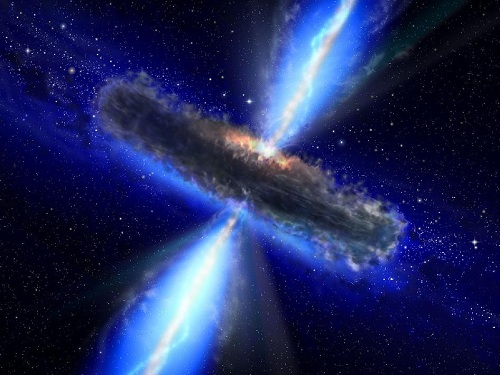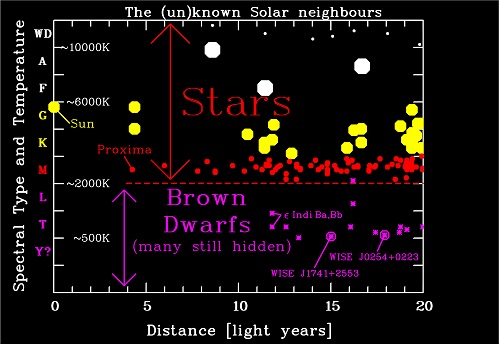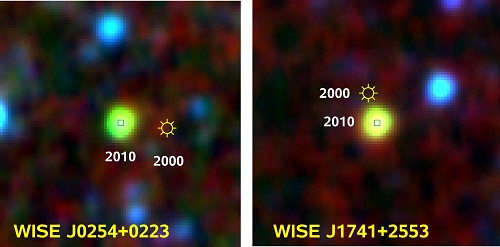Centauri Dreams
Imagining and Planning Interstellar Exploration
A Trojan Asteroid for Earth
Although the asteroid temporarily called 2010 TK7 was discovered late in 2010, we now learn in the latest issue of Nature that this object is our planet’s first known Trojan asteroid. The term refers to objects that orbit around one of the two Lagrangian points L4 and L5 — these are found 60° ahead of and behind the larger body. Trojans come in various sizes. The Saturn system actually has Trojan moons (Telesto and Calypso, which accompany Tethys, and Helene and Polydeuces, which move in orbital configuration with Dione). Jupiter, Neptune, Mars and now the Earth have all been found to have Trojan asteroids associated with them.
As the paper on this work points out, the viewing geometry poses problems for discovering Trojan asteroids moving with our planet, although we have found unusual objects like the ‘horseshoe orbiters’ 2010 SO16 and 3753 Cruithne. What made the current discovery possible was the Wide-field Infrared Survey Explorer (WISE) satellite, which searched large areas of the sky 90º from the Sun with a high level of astrometric precision (2010 SO16 was identified through the same data). Follow-up study with the Canada-France-Hawaii Telescope in 2011 allowed the orbit of 2010 TK7 to be determined, verifying its status as an Earth Trojan.
It’s worth noting that the NEOWISE component of the WISE mission focused on near-Earth objects like asteroids and comets, observing more than 155,000 main belt asteroids and tracking more than 500 NEOs, including 132 that were being seen for the first time. Trojans are still difficult to spot, but 2010 TK7 fell within the parameters of the WISE coverage area:
“These asteroids dwell mostly in the daylight, making them very hard to see,” said Martin Connors of Athabasca University in Canada, lead author of the paper on the discovery. “But we finally found one, because the object has an unusual orbit that takes it farther away from the sun than what is typical for Trojans. WISE was a game-changer, giving us a point of view difficult to have at Earth’s surface.”
As you can see in the image below, 2010 TK7 follows a complex path that moves it sometimes closer and sometimes farther from the Earth, with the asteroid preceding the Earth at all times as both move around the Sun.
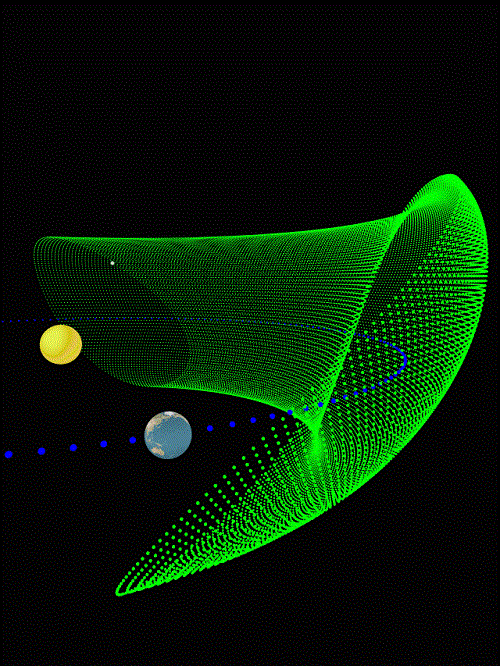
Image: The complete path of asteroid 2010 TK7 (green) during the course of one of its 195-year cycles. The asteroid remains in front of the Earth as they both orbit the Sun. The asteroid is the white sphere, the Sun the yellow sphere, and the dark blue dots trace out the Earth’s orbit. Credit: Paul Wiegert, University of Western Ontario, Canada.
Could a Trojan like this become a tempting target for a space mission? The paper notes the problem: 2010 TK7 is in a highly inclined orbit, traveling far above and below the plane of the Earth’s orbit. The delta-v required is 9.4 km/s. This contrasts with values of below 4 km/s for other near-Earth asteroids, making other objects more likely candidates. In any case, we still have much to learn about this Trojan. Its absolute magnitude allows an estimate of 300 meters for its diameter, making it relatively large among the near-Earth asteroid population. It’s presently about 80 million kilometers from the Earth, and we also learn that no spectral or color information is yet available to tell us whether it is unusual in any way that might justify a mission.
The animation below illustrates the orbit of 2010 TK7.
Image: The movie follows Earth as it travels along its orbit (blue dots) around the sun, so Earth remains at the front of our view. The various objects are not drawn to scale. Asteroid 2010 TK7 has an extreme orbit that takes the asteroid far above and below the plane of Earth’s orbit. The motion above and below the plane is referred to as an epicycle. In addition, the asteroid moves within the plane of Earth’s orbit in what is called libration, circling horizontally around its stable point every 395 years. The clock at upper left shows how the orbit changes over time. The asteroid’s orbit is well understood — over the next ten thousand years, 2010 TK7 will not approach Earth any closer than 20 million kilometers (12.4 million miles), which is more than 50 times the distance from Earth to the moon. Credit: Paul Wiegert, University of Western Ontario, Canada.
The paper is Connors et al., “Earth’s Trojan Asteroid,” Nature 475 (28 July 2011), pp. 481-483 (abstract). See also the discoverers’ article Earth’s First Trojan Asteroid: 2010 TK7.

A Shield from Stellar Eruptions?
We don’t know whether life can exist on a planet circling a red dwarf, but as reported in these pages frequently in the last few years, there have been studies showing that liquid water could persist on the surface of such planets despite the fact that they would most likely be tidally locked, with one side always facing their star. So the potential is there, but we also have to account for flare activity and the question of how life might adapt to it. Perhaps there are protective mechanisms that might shield such planets from the worst such eruptions, a possibility now raised by Ofer Cohen (Harvard-Smithsonian Center for Astrophysics).
Cohen and team have recently gone to work on planets of a far different kind — hot Jupiters crowded up in tight orbits around more Sun-like stars — but the work on gas giants is intended to lead on to a close look at red dwarf planets in similar proximity to violent stellar events. Until that study is complete, we can learn from their work on what happens when a coronal mass ejection (CME) hits a nearby planet. A CME pumps billions of tons of electrically charged hot gas into the Solar System, an event that can cause major disruptions to the Earth’s magnetosphere. It was a CME and ensuing geomagnetic storm that blacked out large regions of Quebec back in 1989.
Much tamer phenomena are likewise markers for solar activity, as anyone who has been fortunate enough to experience the Northern or Southern Lights already knows. My first encounter with the Northern Lights was in Iowa back in my college days, when the northern sky one night seemed to mimic a huge open window with gauzy white curtains being blown by the wind. It was an eerie, though not colorful, phenomenon, and I heard at the time that the lights were fairly rare at our comparatively low latitude. Years later in Iceland I would get the Northern Lights in technicolor one late October, a stunning display that had me standing speechless looking out over Reykjavik’s docks at the rippling and ever changing stream of colors.
Cohen’s work on aurorae shows that distant hot Jupiters should experience the same phenomena, though peaking at 100 to 1000 times the brightness of what we see on Earth. When a Coronal Mass Ejection hits a gas giant just a few million miles from its star, the planet would be subject to extreme forces, feeling the concentrated might of the blast. The immediate effect would be a weakening of the planet’s magnetic shield. And as CME particles reaches the planet’s atmosphere, the auroral lights would manifest themselves first as a ring around the equator that would, in the course of six hours, move up and down toward the planetary poles.
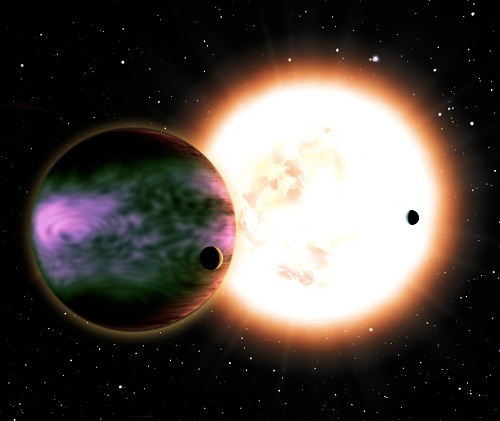
Image: This artist’s conception shows a “hot Jupiter” and its two hypothetical moons with a sunlike star in the background. The planet is cloaked in brilliant aurorae triggered by the impact of a coronal mass ejection. Theoretical calculations suggest that those aurorae could be 100-1000 times brighter than Earth’s. Credit: David A. Aguilar (CfA).
Remarkably, the hot Jupiter itself seems relatively well protected by its magnetic field. Cohen’s simulations show that the initial orientation of the planetary magnetosphere (which is elongated into a comet-like tail by the stellar wind) is almost perpendicular to the CME’s direction, with the result that the CME is modified in highly complex ways. But the key finding is that even in such extreme conditions, the planet’s atmosphere can be shielded from erosion. From the paper:
Despite its proximity to the host star, we find that the planet is well shielded from being eroded by the CME, even with a relatively weak intrinsic magnetic field of 0.5 G. We also find that the planetary angular momentum loss associated with a disconnection of part of the planetary tail is negligible compared to the total planetary angular momentum. Our simulation suggests that the planetary magnetosphere can be significantly affected by the CME event, and that the energization of the planetary magnetospheric-ionospheric system might be much higher than in the Earth. It also suggests a transition in the magnetospheric Alfvén wings [wedge-shaped structures of magnetospheric plasma] configuration during the event, as well as a rotation of the whole current system by 90°. However, our simulation cannot provide such detailed information about the planetary properties; investigation of these aspects of the interaction requires a detailed numerical model for the planetary magnetosphere.
So a hot Jupiter gets pummeled by a CME, but the power of its protective mechanism is surprising, and as Cohen points out in this CfA news release, “…even a planet with a magnetic field much weaker than Jupiter’s would stay relatively safe.” How to extend such findings in the direction of stellar activity on red dwarfs and the consequent effect on planets there? We have much to learn, but perhaps this team’s continuing investigation in that direction will clarify whether discovering a planet in a red dwarf’s ‘habitable zone’ really does flag a potential for exoplanetary life.
The paper is Cohen et al., “The Dynamics of Stellar Coronae Harboring Hot-jupiters II. A Space Weather Event on A Hot-jupiter,” accepted by the Astrophysical Journal (preprint).

Water in the Distant Universe
Although I wasn’t able to do any traveling during my recent week off, I did manage to get in some backed up reading, including Iain Banks’ Use of Weapons (2008), the third in his series of novels about the interstellar civilization known as ‘The Culture.’ I’ve developed quite an interest in Banks, whose novels paint a future so finely textured that the memory of it lingers like a flashback to an actual experience, an intuitive, almost mystical sense that I remember having encountered when I first read Cordwainer Smith (Paul Linebarger) many years ago (some of Jay Lake’s short stories also have this effect on me). Thanks to the many Centauri Dreams readers who put me on to Banks’ novels.
Among the events in astrophysics that occurred during my absence, I was most struck by the discovery of vast amounts of water surrounding a black hole more than 12 billion light years away, an indication, in the words of JPL’s Matt Bradford, that “water is pervasive throughout the universe, even at the very earliest times.” This one triggers a more traditional science fictional sense of wonder in a major way, if for no other reason than the sheer scale of the objects involved. The quasar APM 08279+5255 harbors a black hole 20 billion times more massive than the Sun and, according to this NASA news release, produces an amount of energy equal to a thousand trillion suns. That’s 65,000 times the energy output of the entire Milky Way galaxy.
Image: This artist’s concept illustrates a quasar, or feeding black hole, similar to APM 08279+5255, where astronomers discovered huge amounts of water vapor. Gas and dust likely form a torus around the central black hole, with clouds of charged gas above and below. X-rays emerge from the very central region, while thermal infrared radiation is emitted by dust throughout most of the torus. While this figure shows the quasar’s torus approximately edge-on, the torus around APM 08279+5255 is likely positioned face-on from our point of view. Credit: NASA/ESA.
The huge black hole, pulling in surrounding gas and dust and spewing out energy, is what powers up the quasar, an object of a class known to contain the most luminous and most energetic objects in the universe. And what the paper on this work tells us is that the cloud of water vapor associated with this object contains the equivalent of 140 trillion times all the water in the world’s oceans. Studying such phenomena tell us much about the early universe, according to co-author Alberto Bolatto:
“Because the light we are seeing left this quasar more than 12 billion years ago, we are seeing water that was present only some 1.6 billion years after the beginning of the Universe. This discovery pushes the detection of water 1 billion years closer to the Big Bang than any previous find.”
The water vapor is found in a gaseous region that spans hundreds of light years, a cloud whose temperature is minus 53 degrees Celsius, unusually warm in astronomical terms. In fact, the cloud is five times hotter and between 10 and 100 times denser than gases typical to galaxies like the Milky Way. There seems to be enough water vapor — and other molecules, including carbon monoxide — to feed the black hole until it grows to six times its current size, though at this point no one can say how much of the gas will actually wind up being absorbed by it.
While water vapor is present in the Milky Way, it appears in amounts 4000 times less massive than what we find in the quasar, in part because most of the water in our galaxy is frozen into ice. The discovery is owed to work done with the Z-Spec spectrograph at the Caltech Submillimeter Observatory on Mauna Kea, operating in the millimeter wavelengths. And it’s an indication of more to come at these wavelengths, according to Jason Glenn (University of Colorado at Boulder), who is a co-principal investigator on the Z-Spec:
“Breakthroughs are coming fast in millimeter and submillimeter technology, enabling us to study ancient galaxies caught in the act of forming stars and supermassive black holes. The excellent sensitivity of Z-Spec and similar technology will allow astronomers to continue to make important and surprising findings related to distant celestial objects in the early universe, with implications for how our own Milky Way galaxy formed.”
Astronomers including the authors of this study are working on the design for CCAT, a 25-meter telescope destined for Chile’s Atacama desert, which will push yet deeper into the universe at millimeter and submillimeter wavelengths. We can expect CCAT to continue the study of gas content and water vapor in some of the earliest galaxies in the universe. The current paper is Bradford et al., “The Water Vapor Spectrum of APM 08279+5255: X-Ray Heating and Infrared Pumping over Hundreds of Parsecs,” accepted by Astrophysical Journal Letters (preprint).

A Brief Summer Break
It hasn’t escaped my attention that in the past seven years, I’ve taken no more than a couple of days off at a time from writing Centauri Dreams posts. Now that the doldrums of summer are here in the northern hemisphere, it seems a good time to take a somewhat longer break. Not that I’ll stay away if something major happens — if Debra Fischer announces rocky worlds around Centauri B, for example, I’ll be all over the story. But a week off will provide the chance to reflect, recharge, and get in some backed up but necessary reading. I’ll plan to have the next Centauri Dreams post up, then, some time next week, probably by the 27th, and then back to normal.
Two Relatively Near Brown Dwarfs
Two brown dwarfs relatively near to the Sun may be just the first such objects we’ll soon identify with data from the WISE (Wide-field Infrared Survey Explorer) satellite. Ralf-Dieter Scholz (Leibniz-Institut für Astrophysik, Potsdam) and colleagues have gone to work on a search for brown dwarfs with high proper motion, looking for brown dwarfs in the immediate solar neighborhood using not just the preliminary WISE data release but the previous near-infrared (2MASS) and deep optical (SDSS) surveys. The search has already begun to pay off.
The two brown dwarf discoveries — WISE J0254+0223 and WISE J1741+2553 — are at estimated distances of 15 and 18 light years respectively. Their strong infrared signature and their extremely faint appearance at visible wavelengths attracted the team’s attention, and both show the high proper motion across the sky that flags nearby stellar objects. The team was able to use the Large Binocular Telescope (LBT) in Arizona to determine spectral type and distance more accurately. Interestingly, both objects fit into the category of T-type brown dwarfs, at the boundary of the still not well defined class of Y-type brown dwarfs.
Image: The (un)known Solar neighbors. The stars are shown with symbols of different sizes and colours, roughly corresponding to their real sizes and spectral types. Most stars in the Solar neighborhood are red dwarf stars of spectral type M (in the middle of the figure) with surface temperatures of slightly more than 2000 Kelvin. Proxima, our nearest known neighbor, also belongs to this class. The number of brown dwarf discoveries (almost all with spectral types L and T, and surface temperatures below 2000 K) is already higher than the number of white dwarfs (shown as small white dots at the top). The two nearest brown dwarfs, epsilon Indi Ba and Bb, the discovery of which was reported by the AIP in 2003 and 2004, and the newly found objects are marked. (Credit: AIP).
Do brown dwarfs, hitherto undetected, surround us in large numbers? We certainly can’t rule out the possibility, and we can expect much more data mining from the riches WISE has accumulated. And yes, the case for a brown dwarf closer than the Alpha Centauri stars is still open, making the brown dwarf hunt of unusual interest for identifying potential targets for future probes. But the two brown dwarfs in question could prove useful in many ways in their own right, as the paper on this work notes:
While WISE J0254+0223 and WISE J1741+2553 are likely similar to the few other T8-T10 brown dwarfs known, they are the first ultracool brown dwarfs detected in both 2MASS and SDSS. With their relatively bright magnitudes they are excellent targets for detailed spectroscopic investigations and for high resolution imaging in search of possible binarity. They may become important laboratory sources at the boundary between the T-type and the suggested Y-type (Kirkpatrick et al. 1999) classes of brown dwarfs.
Image: False-colour images of the two brown dwarf discoveries WISE J0254+0223 and WISE J1741+2553 (composite of three images taken by the Wide-field Infrared Survey Explorer (WISE) with different filters in the infrared). In the WISE colours, the extremely cool brown dwarfs appear as yellow-green objects. The positions of the objects as observed by a previous near-infrared sky survey about ten years before the WISE observations are also marked. Every image covers a sky field about 200 times smaller than the full moon. After 700 and 1200 years, respectively, the proper motions of the two objects lead to a shift in their position as large as the full moon diameter. (Credit: AIP, NASA/IPAC Infrared Science Archive).
The paper is Scholz et al., “Two very nearby (d ~ 5 pc) ultracool brown dwarfs detected by their large proper motions from WISE, 2MASS, and SDSS data” (preprint).

A Binary System on the Edge of Merger
A pair of white dwarf stars too close together to distinguish visually may help us in the hunt for gravitational waves, while potentially explaining a whole class of rare, relatively faint supernovae. The system in question — called SDSS J065133.33+284423.3, or J0651 for short — was found during a spectroscopic survey looking for extremely low mass white dwarfs. J0651 includes one white dwarf with about a quarter of the Sun’s mass compacted down to Neptune-size, along with a companion white dwarf that is half the Sun’s mass and about the size of the Earth.
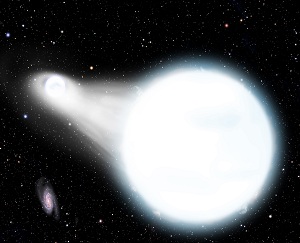
Usefully, this is a system oriented so that we can observe eclipses of each star by the other, which is how we can measure orbital parameters, masses and white dwarf radii. The General Theory of Relativity predicts that close pairs of stars produce gravitational waves that are ripples in the curvature of spacetime, and as the paper on the new work points out, the binary pulsar PSR B1913+16 has already given us indirect evidence for such waves through the gradual decay of the orbit as predicted by Einstein’s theory. J0651 now emerges as an opportunity to study gravitational waves again by measuring small changes in the stars’ orbital periods.
Image: Two white dwarfs have been discovered on the brink of a merger. In just 900,000 years, material will start to stream from one star to the other (as shown in this artist’s conception), beginning the process that may end with a spectacular supernova explosion. Watching these stars fall in will allow astronomers to test Einstein’s general theory of relativity as well as the origin of a special class of supernovae. Credit: David A. Aguilar (CfA)
Thus we have an unusually useful celestial laboratory. Because there seems to be no exchange of mass, the change in separation over time should be easy to measure. From the paper:
We…predict that J0651’s orbital period is shrinking by 2.7 × 10-4 sec per year due to gravitational wave radiation. The expected change in period adds up to a 5.5 sec change in time-of-eclipse in one year. When we measure this change we expect to provide yet another fundamental test of general relativity and the existence of gravitational waves.
It’s a test that could potentially be confirmed by the proposed ESA/NASA Laser Interferometer Space Antenna (LISA) mission, which the authors predict could detect this gravitational wave source within its first week of operation considering its peak sensitivity at frequencies corresponding to orbital periods like those found here. The white dwarfs complete an orbit in just 13 minutes and will merge quickly in astronomical time. On that issue the paper comments:
The absence of mass transfer in J0651 is perhaps surprising given how quickly it will merge. In all known binaries with periods comparable to J0651… one star fills its Roche lobe and transfers mass to its companion. Our data show that the J0651 primary has a Roche lobe radius 1.5 times its current radius. Under the assumption of energy and angular momentum loss due to gravitational wave radiation, the primary WD will reach its Roche lobe radius at an orbital period of 6.5 minutes in 0.9 Myr.
What happens when the stars merge 900,000 years from now is another issue. In some models, merging white dwarf pairs are the source of faint stellar explosions called underluminous supernovae. Such objects are 10 to 100 times less luminous than normal Type Ia supernovae. The supernova SN 2005E, for example, can be explained using parameters similar to the J0651 system, but mass transfer between the two stars could lead to a variety of different outcomes. Thus the need for the ongoing survey of low mass white dwarf systems using the MMT telescope at the Whipple Observatory on Mt. Hopkins, Arizona, from which the current paper draws its data.
The two white dwarfs are circling at a speed of some 600 kilometers per second. “If there were aliens living on a planet around this star system, they would see one of their two suns disappear every 6 minutes – a fantastic light show.” said Smithsonian astronomer and co-author Mukremin Kilic. So strong is the mutual gravitational pull of the white dwarfs here that the lower-mass star is deformed by three percent and, as this Harvard-Smithsonian Center for Astrophysics news release notes, a similar bulge on our own planet would result in tides 190 kilometers high.
The paper is Brown et al., “A 12 minute Orbital Period Detached White Dwarf Eclipsing Binary,” accepted by Astrophysical Journal Letters and available as a preprint.

